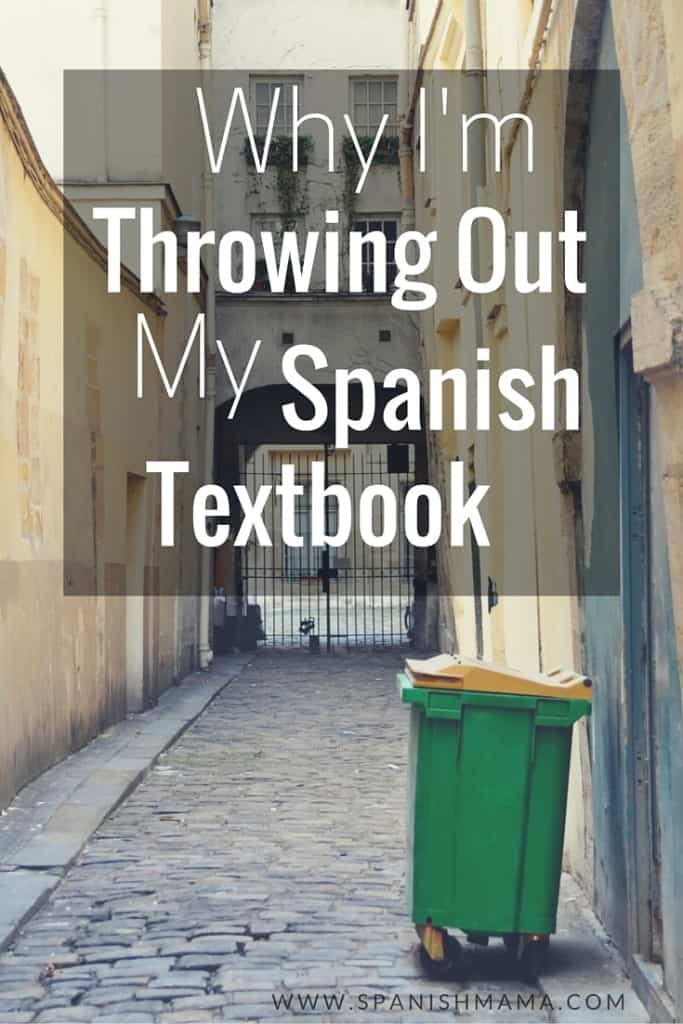Why I’m Throwing Out my Spanish Textbook
Inside: Teaching Spanish without a textbook.
I finally did it.
Last year, I half-used my textbook, wanting to get rid of it and yet not quite knowing what to do instead. It had been a year of feverish research, scrolling through blog posts late at night, reading opposing opinions and sometimes coming away more confused than ever.
I knew at a gut-level there was a better way. Perhaps it was that years of being homeschooled had impressed the word textbook into my mind as a dirty word. My mother mostly eschewed traditional textbooks for subjects like history and language arts. We were too busy reading real books– living books, as Charlotte Mason termed them. Drills, passages out of context, and multiple choice answers seemed like an oddity, as if one were being asked to study and label the parts of a bicycle instead of just getting on and riding it.
Like most of you, I started with a thick textbook when I first taught high school Spanish. My formal background is Elementary Education, and I’d dabbled in TPRS when tutoring and teaching Spanish in younger grades. So when it came to teaching high school, it was me, my gut, and the textbook. And the internet. Thank goodness for the internet!
Over the first few years, I saw that the textbook wasn’t best. I couldn’t have told you why at first, but I think I can finally explain what wasn’t working and why.
As you read, keep in mind that here I’m referring to traditional textbooks– there may very well be textbooks out there that work better than mine did. Also, I’m not in the “better a bad day of TPRS than a good day with the textbook” camp. To be honest, some of my lessons this year were embarrassingly bad. I’m not about to say that an amazing teacher working within the constraints of a textbook couldn’t possibly teach as well I can on a good or bad day. The point I’d like to consider is whether the textbook is the best tool for teaching language.
(Update: since writing this post, I’ve since created am entire page for all my posts on Textbook-Free Spanish Teaching.)
TEACHING SPANISH WITHOUT A TEXTBOOK: WHY?
So, why am I throwing out my textbook? Basically, my textbook does not “get”
- proficiency (where we are going and what can the student do), or
- acquisition (how language is taken in, primarily through comprehensible input).
Once I began to understand proficiency and acquisition, it all began to make sense. Research was telling me that a proficiency-based, comprehensible-input-driven Spanish classroom is the path to acquisition. The textbook was just on much a different path, and in fact never used the terms proficiency, comprehensible input, or acquisition.
I’ve got some concrete reasons why I’m throwing out the textbook, but I’d like to unpack proficiency and acquisition first. I’m no expert, but I will cite some authors who are.
TEACHING TO PROFICIENCY: WHERE ARE WE GOING?
Most textbooks plan to give students an introduction to the language: to teach them about Spanish. Over the course of a few years, students are taught the entirety of Spanish grammar and a smattering of vocabulary themes. Their progress is marked by how many tenses they can use and the accuracy of their sentences, how many vocabulary lists the students have “memorized.”
As I understand it, in the proficiency-based classroom, expressing and understanding meaning is the ultimate goal. The point is not what material has been covered: I am an advanced Spanish student because I can conjugate verbs in the subjunctive. The question is what the students can do to express meaning. Beginners understand and produce simple messages; progress is shown as those messages grow in complexity.
The real goal is to actually “rise in proficiency” as Joshua Cabral at World Language Classroom says. Progression through proficiency mimics the process that children go through in learning their own native language. They begin with words, move to phrases, and eventually string together increasingly complex sentences to communicate meaning.
Proficiency is what a student can do in an unrehearsed context and therefore a true measure of one’s ability in a language. Once I became familiar with the ACTFL Standards and Can-Do Statements, I realized that my lessons– based on the textbook– were designed to help students memorize rules and terms to pass a test. Teaching to actual proficiency was going to require entirely new methods, and certainly new assessments.
This may seem like a lot of theory, but it has a huge impact on where we spend our time. Where we were are going directly affects all the little things we do in class, day in and day out. Will we spend precious hours drilling rules and marking exercises with a red pen? Will we spend time reading real books and having interesting discussions? Are we trying to ride the bike or become bike mechanics?
ACQUISITION: HOW DO STUDENTS “GET” LANGUAGE?
Most textbooks are based on the explicit theory of language: that language can be broken into rules which are taught, memorized, and drilled.
Sara Elizabeth Cottrell at Musicuentos has a good breakdown of the approach textbooks take:
The problem with this focus on “forms” is that it assumes that language is acquired through learning about the language. Stephen Krashen and and Bill Van Patten have done extensive work researching the difference between learning and acquisition, and both argue that acquisition is achieved through massive amounts of comprehensible input. I still think accuracy has its place, but CI is ultimately how language gets into our heads.
It’s a lot of semantics– when I looked up learn in the dictionary, acquire was a term used to describe the word learn– but this distinction is important. Before, for example, I would have assumed that because a student could correctly conjugate verbs in the present tense, that they had “acquired” the present tense. And I would move onto the next grammar point. If a student couldn’t correctly conjugate verbs, I would have assumed they needed more conjugation exercises– not more compelling, comprehensible input.
Bill Van Patten explains this really well in this series:
So, those are the theoretical reasons. Getting down to the nitty-gritty, here are more immediate reasons why the textbook wasn’t working.
1. THE CRAZY VOCABULARY LISTS
I am not entirely ready to abandon vocabulary lists, but I am done, done, done with the ones my textbook created! They usually center on a specific theme, and are unbearably long. Students will make flash cards, take quizzes, see the words in boring worksheets, and then never see 75% of them ever again. But words learned in themes like this, out of context, individually, are actually really hard to get into the long-term memory.
I am increasingly convinced that if lists are to be given, they should be given in context, chunked (set in phrases) if possible, and short. They should also be needed words. My textbook started with greetings, which is a logical place to start. However, since this was the book’s opportunity to introduce greetings, every possible greeting was taught right then. My students authentically needed ¿Cómo te llamas? right away, but el placer es mío, el gusto es mío, igualmente, and encantado/a were overkill. For students two weeks into Spanish class, mucho gusto is plenty to get by on.
I don’t mean those terms should never be introduced. When we do speed dating activities, the students love variety and I build the terms in. But the textbook’s method of introducing every variant on a certain theme, at once, is overwhelming. At the end of the day, students still walk away with ¿Cómo te llamas? and not the other terms, even if all of them were “memorized” and quizzed.
As an aside, Charlotte Mason advocated fewer, but higher-quality picture books and poems for young children. You will hear now that parents should expose their children to many, many, books and poems. The thought is that the more vocabulary and stories children hear, the better and more diverse their own language will be. I’ve come to agree with Mason that fewer stories– but dearly loved, memorized, recited, stories– will actually produce richer language. Sometimes more is less.
2. NOT ORDERED BY HIGH-FREQUENCY
Vocabulary and grammar are introduced as complete, deep themes, to be thoroughly studied before moving on. In my textbook, students spend the first months learning greetings, classroom objects and subjects, ar verbs, numbers, days, etc. Now, I have some fun games to make this less painless. But try creating compelling content and interesting discussions with those topics! –AR verbs are presented first because the pattern is “easy,” not because they are actually higher frequency verbs. So my students were learning la física and descansar before tener and hay.
If I were required to use the textbook, I would still make sure to incorporate some storytelling from the get-go and introduce the “Super Seven” that Terry Waltz came up with:
3. GRAMMAR AS THE PATH TO LANGUAGE ACQUISITION
Most textbooks look at a language and break it down into pieces of grammar. In Spanish, the first year is generally focused on the present tense and all the parts that go with it: ser vs. estar, direct object pronouns, all regular, irregular, and stem-changing verbs.
Instead of introducing real content that includes these patterns, the language is introduced grammar concept by grammar concept and then drilled. When teaching ser vs. estar, for example, the students take notes on every. single. rule. that applies to ser vs. estar. Students who can barely express and understand meaning at a very basic (novice) level are expected to “master” this quite difficult concept because it falls under the present-tense Spanish-One category.
I haven’t, actually, hopped onto the “grammar is evil” boat. I think there’s a time for it. But I used to think that in learning the rules for accuracy, we were acquiring Spanish. I now see grammar as a tool for accuracy, specifically.
4. TOO LITTLE COMPREHENSIBLE INPUT
Our textbooks were packed. They just weren’t packed with comprehensible input. Aside from some videos, cultural notes, and song lyrics or emails here and there, the bulk of the program was “practice.” My students need massive amounts of quality input– to be read, heard, watched– to understand and speak Spanish.
Most of the input they DID see in the textbook, unfortunately, was confusing (= not comprehensible), and made them feel like Spanish was just “too hard.” I think this was because we began with explanations and lists, practiced the skills, and that led up to the content. Of course, because the vocabulary and grammar went really “deep,” it was hard to master both thoroughly enough to be comfortable with the related content.
Here’s another video from Musicuentos that explores grammar, input, and “skill” a but further:
5. COMPREHENSIBLE INPUT THAT ISN’T COMPELLING
Of the little CI available in textbooks, most of it is sad, sad, sad. This is true of most textbooks anyway: content is soon outdated, boring, irrelevant, and low-quality as far as literature goes. Most of time, grammar (with vocab), was the point. Content was there as a way to practice the particular “skill.”
Now language, of course, is a means for communicating an actual message, a story, or an emotion. If the message or story is boring, the students will think that language is boring. If the students don’t feel invested in our discussion–i.e., they feel no emotion– then Spanish is tedious.
Reading real living books this year, Esperanza and Piratas del Caribe, showed me what can happen when input is absolutely compelling. All of a sudden we were debating whether romance or money was more important (in Spanish) and boy, did they pay attention to what the others were saying! In a thank-you note at the end of the year, one student wrote, “Now I know the priorities of the guys in our class, hah.” These moments were hard to come by with a textbook. Authentic resources and non-fiction have their places, but it’s pretty hard to find anything as compelling as a story.
Again, here’s another video from Musicuentos to explain this better than I can:
Whew. This post was a long time in coming. The internet can be both an awesome resource and a path to self-condemnation for teachers. I know that many of you don’t have flexibility like I do, and have to follow a set curriculum. I know that many of you have zero time to plan, and go home to kids or other responsibilities. Throwing out your textbook just isn’t realistic right now. Hopefully my complaints against the textbook can just help you think through how to use yours and work with what you have.
Again, Musicuentos to the rescue with a Checklist on when to use textbook activities and advice on when you are Forced to Adapt a Textbook. Be sure to follow Joshua Cabral from World Language Classroom on Periscope– he has great scopes on teaching for Proficiency, regardless of what materials you use. Throw Away Your Textbook is another good resource.
What about you? Do you love your textbook? Are you already teaching Spanish without a textbook? Do you want to throw it out, but can’t? Are you totally starting from scratch like me? I’d love to hear your experience!
Like it? Pin it!









This is the BEST
I start teaching high school Spanish this week. I have a standard textbook to start with, but have been trying to find more interactive methods that will help the children learn & enjoy Spanish.
I am new to teaching high school Spanish, but come from a dual immersion (Spanish) elementary school. As a native Spanish speaker and a second language learner, I hate the way high school Spanish is taught, with a textbook. I would love to use more meaningful lessons and have my students be thoroughly engaged and excited about learning a second language. Thanks for your post. It really has me thinking…
This is my first year teaching Spanish and I found this article amazing! This is the same teaching style that I find much more efficient and productive. Thank you for this article as it has helped me to continue with my own methods and approaches to teaching Spanish rather than the traditional format. I continue to use and reference your site and articles for my lessons and class.
Wow. That was a lot to take in, but it makes loads of sense. I’ve taught with textbooks and without, and while I prefer to follow my own curriculum, it is so much more work! I’m not sure I have the time to prepare complete lessons on my own, but I will definitely move slowly away from relying so much on the textbook.
I think you are on the right track, but in my experience as a World Languages department chair, I’ve found that the textbook is critical. We originally thought, as is trendy these days, that getting rid of the textbook would make everything authentic and awesome. Unfortunately, we found that there was serious problems in consistency. The first consistency problem was from day to day. One day’s lessons would be great, the next would be mediocre (or worse). The second consistency problem was from teacher to teacher. There was also a problem of too large a gap between different teachers teaching the same class. You’d expect some differences, but without the textbook to anchor the curriculum, we basically produced Spanish 2 students with very little vocab in common.
As a result, we decided to go back to the textbooks. We use them as a basis for the class but we also increase comprehensible input and TPR strategies. Teachers are required to do their own current events or other similar projects. ‘The book, much to our surprise, was significantly better resource than we got by forcing our teachers to search out materials on their planning periods. Honestly, thinking back….we struggle to understand why we thought surfing the internet on our planning periods was better than using a text (written by people who dedicate their lives to putting content together).
To Lamar, I disagree with you in certain aspects. Because the issue you were having by getting rid of the textbook was a lack of coherence and unity among distinct teachers in the same program. And though you do need that unity, it doesn’t necessarily have to be achieved with a textbook. You would, however, need a very detailed syllabus, a common store of material for everyone to share, carefully linked lesson plans, etc. And that is a lot of work that can be easily solved with a textbook.
However, a textbook written by professionals tends to have vast generalizations based on conservative teaching styles to make it acceptable for a bigger public. That’s not necessarily the best route to take. I’ve worked with some horrible textbooks, and I’ve never found one that is really good. Also, “surfing the internet” is much different than careful lesson planning, based on research from the internet and other sources, to create an original and effective lesson.
But, as a final point–from personal experience, students tend to like having a textbook. It gives them a sense of accomplishment that they have gotten through a book, and works as a guide and reference. But just because they are used to it doesn’t mean that it’s the best way to learn a language. This is particularly true in secondary school, where teachers have more independence and materials available tend to be fairly deplorable. I had horrible experiences learning Spanish in secondary school as Elisebeth makes all too clear.
I agree, finishing a “textbook” does give students a sense of accomplishment. So, if the teacher is not going to follow the textbook, I think they should tell that to the students. It helps to manage expectations and to help them not get lost.
Not that I think of it: I remember when I was a student and the teacher jumped around in the textbook. It was disorienting. I didn’t realize that this was a great teacher in his/her element. So, I think it’s key to just let students know: “Class, we will be jumping around the textbook, but trust me, I’m going to make sure you’re prepared to blow these tests out of the water.”
Furthermore, students have a very different notion of time, compared teachers. One school year feels like 5 years to a 12 year old. So, you need to give them structure, at least. Something to let them know their is light at the end of the tunnel, and we are certainly moving in THAT direction. Crazy as it may seems, strictly working through a textbook does give students that sense of stability. There is already so much “unknown” going on it can be dizzying. But if they know they’ll be on chapter 13 next week, they can set expectations.
And if the teacher is going to jump around the textbook or even use different materials, they should keep a running tab of WHAT has already been covered, and what remains to be learned. SHOW that list to students. Post it on the side of the blackboard. Whatever. Get creative. But the stability that comes from just this one gesture reduces stress and allows you to get results.
I agree with all comments. If you tried throwing the text away and it was hit and miss days, try using what is GOOD from the text and skip the bad stuff. Do not teach BAD stuff to your students. You know when it’s bad and when it’s good. Follow the lesson plan format. Fun Bell Activity, SHORT lesson by you (demoed) and an engaging activity that they are going to like doing to reinforce the lesson. Close with a Exit ticket (check for understanding). Dedicate a day weekly to student driven cultural activities that they do the research and presentations on. Dedicate a day to culturally relevant videos that are either movies from Latin America or youtube vloggers that dedicate their lives to well made/produced videos in Spanish that relate to real life culture in Spanish speaking countries. Use games and other sources that are interesting. If all you are using is a textbook it’s a shame. Etc., etc…….